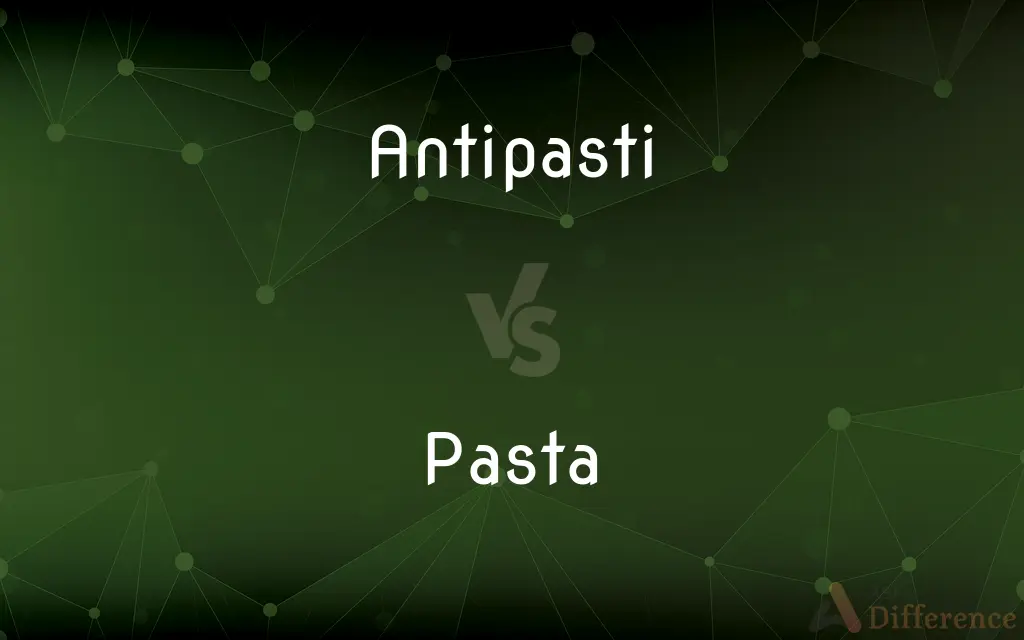Antipasti vs. Pasta — What's the Difference?
By Maham Liaqat & Fiza Rafique — Updated on April 16, 2024
Antipasti are a variety of Italian appetizers designed to stimulate the appetite before main meal, consisting of a mix of savory bites like cured meats, cheeses whereas pasta is a staple Italian dish made from durum wheat dough, shaped into various forms.

Difference Between Antipasti and Pasta
Table of Contents
ADVERTISEMENT
Key Differences
Antipasti, meaning "before the meal," comprises an assortment of small dishes intended to be eaten before the main course. These can include items such as marinated vegetables, olives, cured meats, and cheeses, offering a light and flavorful start to the meal. On the other hand, pasta is often the main course in a meal, central to Italian cuisine and served in numerous forms like spaghetti, penne, and ravioli, with an array of sauces from simple tomato to rich and creamy alfredo.
While antipasti are characterized by their variety and are meant to be shared among diners to enhance the communal dining experience, pasta dishes are usually served as individual portions, highlighting the versatility of pasta in accommodating a wide range of dietary preferences and flavors. Conversely, antipasti serve as a way to sample a broader spectrum of flavors and textures without committing to a single dish.
The preparation of antipasti is generally straightforward, involving minimal cooking and mostly assembly of high-quality ingredients to showcase their natural flavors. Pasta preparation, however, can range from simple to complex, involving various cooking techniques and ingredients to create a balanced dish, with the pasta itself sometimes made fresh from scratch.
In terms of nutritional content, antipasti can be light and healthy depending on the choices made, such as grilled vegetables and seafood, but they can also include richer items like cheeses and cured meats. Pasta, while primarily carbohydrate-rich, can be part of a balanced meal when combined with proteins and vegetables and portioned appropriately.
Antipasti are often considered an introduction to the larger meal, setting the stage for what’s to come, and reflecting the Italian culinary philosophy of enjoying food slowly and socially. Pasta, while it can also be enjoyed socially, typically represents the sustenance portion of the meal, often leaving diners satisfied and full.
ADVERTISEMENT
Comparison Chart
Course
Appetizer, served before the main meal.
Main course, central to the meal.
Typical Ingredients
Cured meats, cheeses, olives, vegetables.
Wheat dough, various sauces, sometimes fillings.
Serving Style
Shared among diners, varied selection.
Individual portions, focused on one type.
Preparation
Minimal cooking, mostly assembly.
Can be simple or complex, often involves cooking.
Nutritional Content
Can vary widely, from light to rich.
High in carbohydrates, often combined with other food groups.
Compare with Definitions
Antipasti
Italian appetizers typically served before a meal.
For our antipasti, we enjoyed a platter of prosciutto, melon, and marinated artichokes.
Pasta
Comes in numerous shapes and sizes, each pairing with specific sauces.
The rigatoni pasta was perfect with the chunky meat sauce.
Antipasti
A reflection of regional Italian cuisines.
Our antipasti featured specialties from Sicily, like caponata and anchovies.
Pasta
A versatile dish that can incorporate a variety of ingredients.
The pasta was tossed with vegetables, chicken, and a light olive oil dressing.
Antipasti
A variety of small dishes designed to stimulate the appetite.
The antipasti selection included stuffed peppers and a variety of cheeses.
Pasta
A staple of Italian cuisine made from durum wheat and water.
We had homemade pasta with a tomato basil sauce.
Antipasti
Light fare to precede heavier courses.
We started with some seafood antipasti, which were fresh and flavorful.
Pasta
Often served as a main dish in Italian meals.
For dinner, the main course was a creamy seafood linguine pasta.
Antipasti
Often served cold or at room temperature.
The antipasti platter was filled with olives and sun-dried tomatoes.
Pasta
Can be fresh or dried, each with a different cooking time and texture.
Fresh pasta cooked quickly, retaining a tender texture.
Antipasti
An appetizer usually consisting of an assortment of foods, such as smoked meats, cheese, fish, and vegetables.
Pasta
Pasta (US: , UK: ; Italian pronunciation: [ˈpasta]) is a type of food typically made from an unleavened dough of wheat flour mixed with water or eggs, and formed into sheets or other shapes, then cooked by boiling or baking. Rice flour, or legumes such as beans or lentils, are sometimes used in place of wheat flour to yield a different taste and texture, or as a gluten-free alternative.
Antipasti
Plural of antipasto
Pasta
A dish originally from Italy consisting of dough made from durum wheat and water, extruded or stamped into various shapes and typically cooked in boiling water.
Pasta
Unleavened dough, made with wheat or other flour, water, and sometimes eggs, that is molded into any of a variety of shapes and boiled.
Pasta
A prepared dish containing pasta as its main ingredient.
Pasta
(uncountable) Dough made from wheat and water and sometimes mixed with egg and formed into various shapes; often sold in dried form and typically boiled for eating.
Pasta
(uncountable) A dish or serving of pasta.
Pasta
(countable) A type of pasta.
Pasta
Any of a variety of edible unleavened doughey preparations made from flour, eggs and water, originating in Italy, and shaped into various forms, such as solid strings (as spaghetti), hollow tubes, or layered squares (ravioli). They may be mixed with various sauces, often having a tomato base, or filled with meat or cheese fillings.
Pasta
Shaped and dried dough made from flour and water and sometimes egg
Common Curiosities
What are common antipasti ingredients?
Common ingredients include olives, cured meats like salami and prosciutto, various cheeses, and marinated vegetables.
Is pasta considered healthy?
Pasta can be part of a healthy diet when eaten in moderation and combined with vegetables and lean proteins.
How should antipasti be selected at a restaurant?
Choose a mix of light and rich items to experience a range of flavors and textures.
What is the key to a great antipasti platter?
Variety and balance of flavors, including sweet, salty, savory, and acidic components.
What's a simple but impressive antipasti dish?
A beautifully arranged platter of sliced prosciutto, assorted cheeses, and fresh figs can be simple yet impressive.
How can I make antipasti more filling?
Include heartier elements like stuffed mushrooms, bean salads, or small bruschettas.
What are some tips for pairing pasta with wine?
Lighter sauces go well with white wines, while richer sauces can be paired with fuller-bodied reds.
Can antipasti be a meal on its own?
Yes, antipasti can be enjoyed as a light meal, especially when a variety of items are served.
What types of sauces are used with pasta?
Sauces range from simple garlic and olive oil to robust meat sauces, creamy alfredo, and fresh pesto.
Can I make fresh pasta at home without special equipment?
Yes, you can make fresh pasta dough and cut it into simple shapes like tagliatelle or use a rolling pin for thinner sheets.
What pasta shape pairs best with meat sauces?
Thicker pasta shapes like rigatoni and pappardelle are great with meat sauces as they hold the sauce well.
How do I cook pasta perfectly?
Cook pasta in a large pot of boiling salted water until it is al dente, or firm to the bite.
What are some creative ways to serve pasta?
Beyond traditional sauces, pasta can be baked with cheese, served in soups, or tossed in salad.
Are there vegetarian options for antipasti and pasta?
Absolutely, both can be adapted to vegetarian preferences with vegetables, cheese, and plant-based proteins.
What is the most unusual pasta shape?
Shapes like trottole, cascatelli, and lanterne are less common and add an element of fun to meals.
Share Your Discovery

Previous Comparison
Muricidal vs. Muricide
Next Comparison
Bullying vs. OstracismAuthor Spotlight
Written by
Maham LiaqatCo-written by
Fiza RafiqueFiza Rafique is a skilled content writer at AskDifference.com, where she meticulously refines and enhances written pieces. Drawing from her vast editorial expertise, Fiza ensures clarity, accuracy, and precision in every article. Passionate about language, she continually seeks to elevate the quality of content for readers worldwide.














































